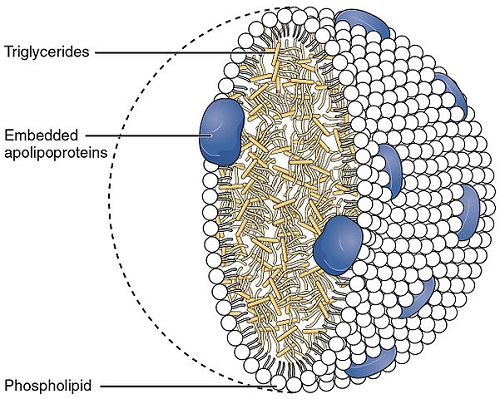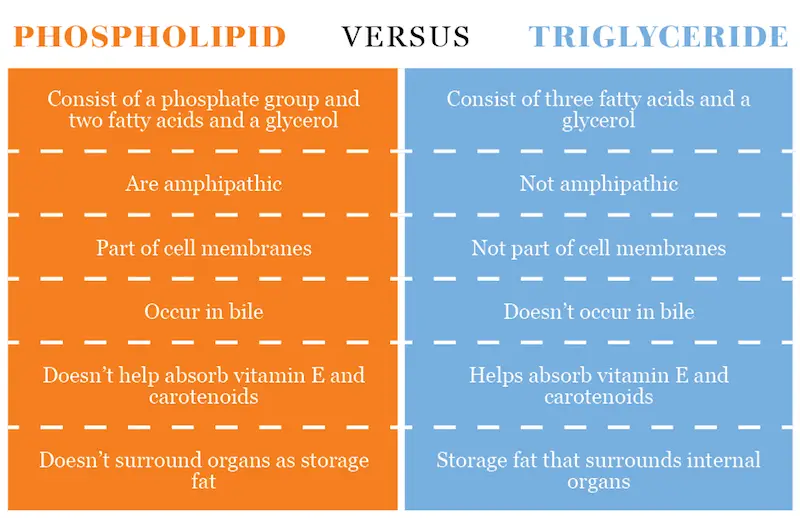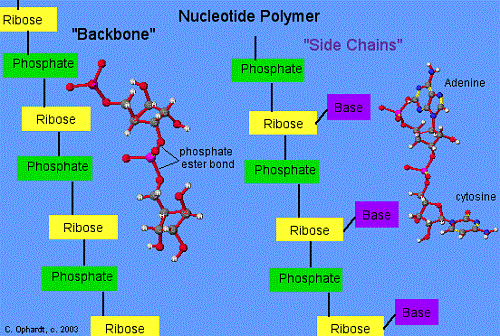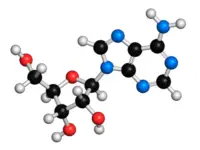What is Phospholipid?
This is a special type of triglyceride in which one fatty acid has been replaced by a phosphate group.
A phospholid consists of two fatty acids and a phosphate group that is attached to a sphingosine or glycerol molecule. The two fatty acids form diacylglycerol, and the third carbon of the glycerol is occupied by a phosphate.
The fatty acid chains are basically hydrocarbon chains that are usually 14-24 carbons in length.
The phosphate may be modified by other molecules attaching to it. For instance, it may have choline attached, forming phosphatidylcholine, and serine attached forming phosphatidylserine. Both these phospholipids commonly occur in cell membranes.
The phosphate group is made of both oxygen and phosphorous, which is important in the structure and function of the molecule. The phosphate is charged and the phospholipid is amphipathic.
Phospholipids are amphipathic:
- Fatty acid tails repel water, they are hydrophobic, and non-polar while the
- phosphate head does not repel water, and it is hydrophilic and polar.
The glycerol molecule joins the phosphate and fatty acids together.
The amphipathic nature of phospholipids is why they are able to form the lipid bilayer (double layer) of cell membranes of organisms.
Phospholipid functions:
-
Form cell membranes
The phospholipids ensure that the membrane is semipermeable and has fluidity.
The phosphate heads point outwards while the fatty acid tails form two rows that face inwards towards each other. The barrier keeps the inside of the cell separate from the outside, but small molecules like oxygen and carbon dioxide can pass through the membrane.
One of the factors that may affect the plasma membrane’s fluidity includes the length of the fatty acid chains. Long fatty acid chains are less flexible than short chains, so short chain fatty acids produce a more flexible membrane. If the fatty acids are unsaturated this also makes the membrane more fluid since double bonds bend the chains more easily.
-
Crucial for digestion
In the digestive system, phospholipids assist in the digestion of fats. Phospholipids found in bile help to emulsify fats, which means break it down into small components for the enzymes to work on.
-
Used in research
Phospholipid vesicles can be artificially created and used to deliver drugs to the cells and study how drugs pass into cells.

What is Triglyceride?
A triglyceride is comprised of a glycerol molecule and three fatty acids, hence the name tri- and –glyceride.
The glycerol consists of three carbons, three hydroxyl groups and five hydrogens.
Fatty acids usually contain about 12 to 18 carbons. The fatty acids bond covalently to each of the oxygen’s in the hydroxyl of the glycerol.
The triglycerides are the main component of body fat in animals, including humans.
Triglycerides can be both made and broken down by means of the glucose catabolism pathways. Glycerol can be phosphorylated to form the molecule glycerol-3-phosphate, which then enters glycolysis.
Fatty acids are catabolized by a process known as beta-oxidation. This occurs in the mitochondria of the cell, in which fatty acid chains are broken down into two carbon units of acetyl groups.
There are two main types of triglycerides:
- Saturated fats. In these all locations where hydrogen atoms could bond to carbon atoms are occupied.
- Unsaturated fats have double bonds between some carbon atoms so there are less places for hydrogens to bond compared with saturated fats.
Unsaturated fats have a low melting point compared with saturated fats.
Natural fatty acids are composed of even numbers of carbon atoms as a result of the pathway of biosynthesis from the two-carbon acetyl CoA.
The names of some triglycerides indicate what the fatty acid is, for instance, palmitin which is derived from palmitic acid.
Functions of Triglycerides:
- It is the storage form of lipids of the body which can be used as energy if needed.
- The triglycerides form stored fat that is found around the organs.
This provides insulation and protection for your internal organs, protecting them from injury. If you are in an accident the fat acts as a shock-absorber.
- Triglycerides help the absorption of important nutrients such as vitamin E and carotenoids.
- Triglycerides transport these nutrients through the circulatory and lymphatic system to where they are needed in the body.
- Triglycerides in the blood carry lipids and sugar from the liver to where they are needed.
- Triglycerides are also a component of the oils found in human skin.
Too much fat in the diet raises the triglyceride levels. Triglycerides can increase the risk of atherosclerosis since they negatively affect plaque development in the blood vessels.
What is the difference between Phospholipid and Triglyceride
- Phospholipids consist of a phosphate group and two fatty acids, triglycerides have three fatty acids.
- Phosphoplipids are amphipathic, fatty acids are not amphipathic.
- Phospholipids are the major component of cell membranes, triglycerides are not found in cell membranes.
- Unlike triglycerides, phospholipids occur in bile to help emulsify fats.
- Unlike phospholipids, triglycerides help absorb vitamin E and carotenoids.
- Triglycerides function as storage fat and surround internal organs, phospholipids don’t.
Table comparing Phospholipid and Triglyceride (Phospholipid vs Triglyceride)

Summary:
- Both a phospholipid and a triglyceride are made of a glycerol molecule and fatty acids but the difference is that a phospholipid has a phosphate group instead of one of the three fatty acids that you find in a triglyceride.
- Phospholipids are amphipathic and have hydrophilic phosphate heads and hydrophobic fatty acid tails.
- Phospholipids are a major component of cell membranes conferring fluidity and semi permeability on membranes.
- Triglycerides form storage fat in the body and surround the internal organs providing insulation and protection.
Author: Dr. Rae Osborn
Dr. Rae Osborn holds Honours Bachelor of Science degrees in Zoology and Entomology, and Masters of Science in Entomology from the University of Natal in South Africa. She has received a PhD in Quantitative Biology from the University of Texas at Arlington. She was a tenured Associate Professor of Biology at Northwestern State University in Louisiana for 10 years. She also completed an AAS Degree in Information Network Specialist and an AAS in Computer Information Systems, at Bossier Parish Community College in Louisiana.












Leave a Reply